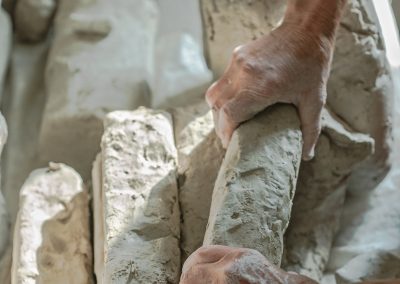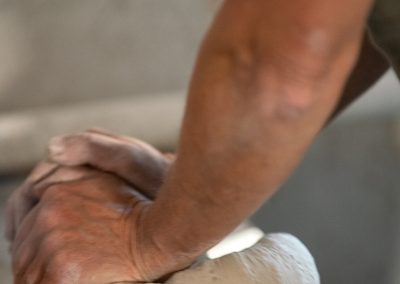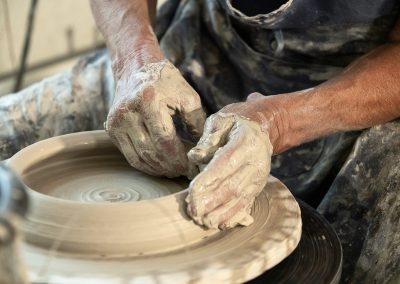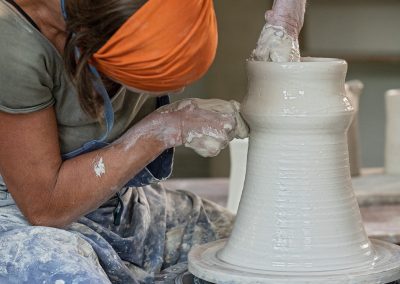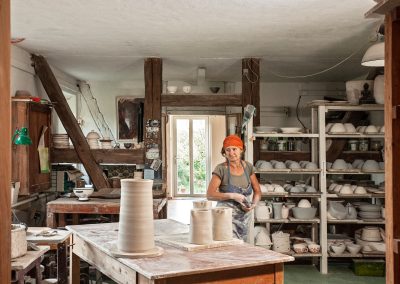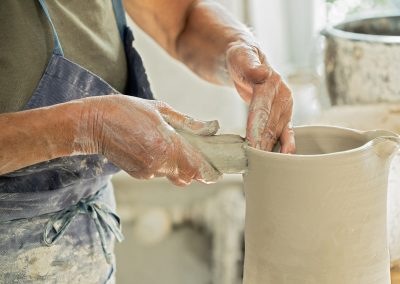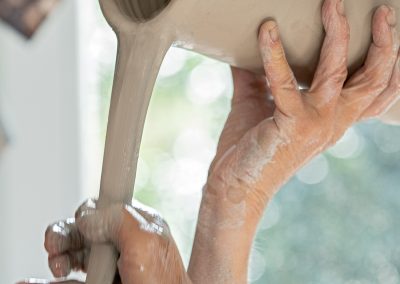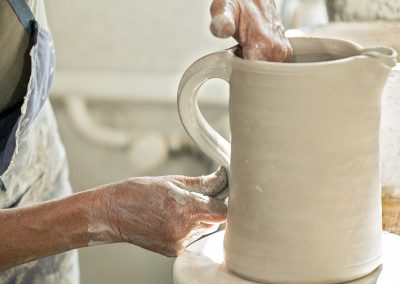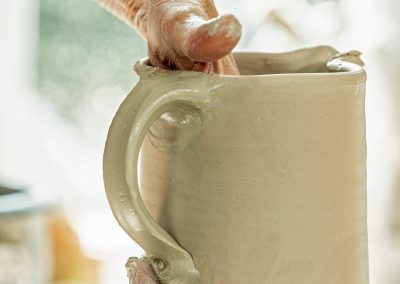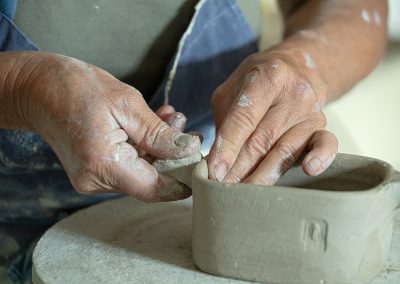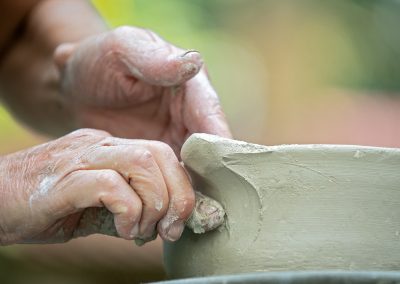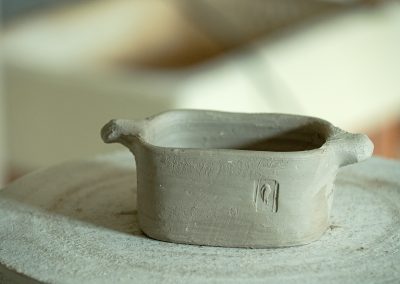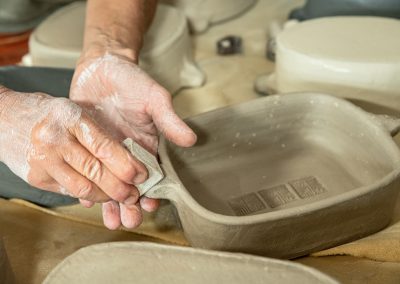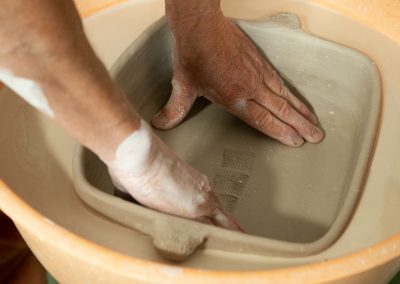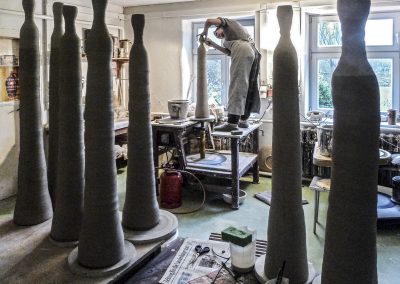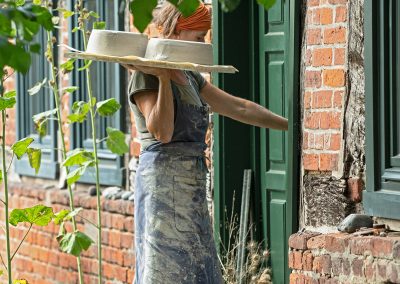My work
About the challenge of firing salt-glazed stoneware in a wood firing kiln
I fire my ceramics in a wood-fired kiln. This enables surfaces and colours that are not produced in an electric or gas kiln.
Continue reading
My way of throwing is to determine the shape in a few simple steps – the pots can spin calmly on the wheel! I imagine how they will later stand in the firing and imagine what colours they will get of it.
The old questions are always new – probably the most important: is the shape suitable for everyday use? Then, do I forego decoration or not, stamping, painting, printing? The Henkel adventure … Which engobe (coloured clay coating) do I apply? What kind of glaze do I choose for the inside?
Long before the shelves in the workshop are filled with thrown pots, I have to think about stacking the kiln. Which pot needs which neighbour? The distance between the shelves is flexible, but I avoid putting shelves too close together. For example – that’s why firing plates and platters is always problematic. Nevertheless I love to make plates.
About four times a year I have enough work made to fill the kiln. The closer I get to the firing, the greater my anticipatory tension becomes. Practical jobs are still to do: make test rings, build cones for temperature measurement. It’s good that all the kiln shelves have already been sanded and brushed with a self-mixed slurry that prevents the work from sticking. At the end I form hundreds of risers (wadding) – these are small balls that I stick to the underside of the ceramic so that it can be more easily removed from the shelves and bottoms after the firing. Also the bottoms of the pots get firing marks which are often beautiful!
Then it’s time. Everything is carried from the workshop across the courtyard to the kiln shed.
The pots are placed in the kiln, the kiln is bricked up, the ash chamber is emptied and the kiln preheated. Provisions for the firing day have to be prepared, as once the firing starts, the kiln cannot be left.
When everything is done, I’ll sleep again, now a little restless in anticipation of the firing. The next morning the kiln is fired with pine wood, that has been split in advance, until around midnight – the thinner the logs, the faster the temperature rises. Sometimes there are visitors to help out. The fascination of wood firing is contagious.
The hours go by fetching wood, and the grate must always be kept covered. You have to be patient if the temperature doesn’t rise steadily – just don’t add too much wood hectically! Help comes in the evening. We are a well-established team for decades. Now I can take a rest and gather new strength.
About four cubic meters of wood are burned before the desired 1320 ° C is reached in the combustion chamber. Every pot in the furnace is then directly surrounded by the flames and the salt thrown in at over 1250 °C to form the glaze and leave it´s traces. If the salt glaze is thick, it is reminiscent of orange peel.
Since the flame only enters the combustion chamber on one side, one side of the pots come in more in contact with it. More salt and occasionally a touch of ash ends up there.
Clay and glazes react with oxygen even after the heating has ended, so that the final colour is created in the first hours of the cooling process. This takes several days.
There are also pieces that have not received enough flame and salt – sometimes it pays to fire them again. In the most successful cases many different shades of colour are created on one pot. Inimitable their transitions!
After two to three days, the kiln door is unbrickrd again and the work is taken out piece by piece. Any wadding from the bottom of the pots is removed, everything is sanded down with a whetstone and sandpaper – the more stubborn areas with a sanding machine or Flex.
It is extremely exhilarating to get a piece of work out of the kiln that has mistakingly made more contact with the flame. Some have a lot of strength at first glance, with others the beauty is rather reserved, almost hidden.
I am very happy to know that this pot will find a new home at some point and then become part of other people’s lives.
My journey through time
1981/88
Technical training and participation in various companies and workshops in the GDR:
- Rheinsberg stoneware factory
- Center for Fine Arts in Neubrandenburg
- Ceramic workshop Brigitte and Roland Möller, Schmiedenfelde
- Workshop group Sigrid Artes, Ursula Zänker and Karl Fulle, Neuruppin
- Establishment of the ceramic workshop in the Grieben wire factory in 1984
- Ceramic workshop Christiane Gregorowius, Hundorf
- Ceramic workshop Uwe Ahlemann, Kleinzerlang
1985
journeyman’s examination in Stahnsdorf
1988
Master craftsman examination in Finsterwalde
Foundation of his own workshop in Techentin / Mecklenburg
1990
Start of participation in exhibitions and ceramic markets
1989/92
workshop group Mecklenburg Birds with Regine Schönemann, Silvia Barke and Wolfgang de Vries:
1992
Inauguration of the first wood-firing kiln in Techentin
2004
Demolition of the kiln and a new improved one built
2006/07
new experiences in wood fire: working in the workshops of
- Nick Collins, England
- Micki Schloessingk, Wales
- Sandy Lockwood and Robert Barron, Australia
2007/11
five times participation in the annual Chassabal Festival in Mungyeong / South Korea
2010
20 years of broken pots and luck – exhibition in Techentin for the anniversary of the wood firing
2012/19
Organization of hinterland in the Mestlin/Mecklenburg cultural center
www.hinterland-marktplatz.de
2020
catalog published for the 30th anniversary of the wood firing.
My vessels can be seen in my own gallery in Techentin, at pottery markets and exhibitions: www.abgelegen.de
Works in public collections:
- Goldberg local history museum
- Bürgel Ceramics Museum
- Ceramics Museum Höhr-Grenzhausen
- Mungyeong Ceramic Museum (South Korea)

